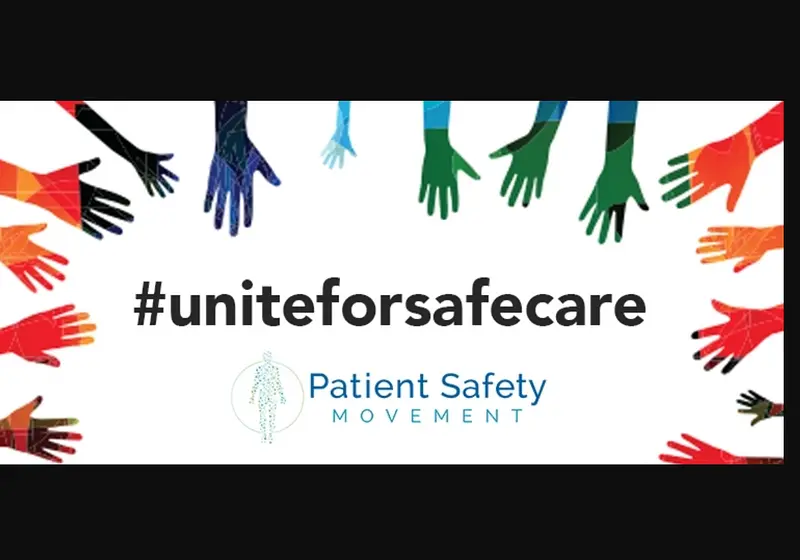When is my chemistry assignment due? How do I recreate that TikTok? I have a sports game this weekend!
These are major priorities on the minds of young people these days, and with thousands of other concerns similar in nature, patient safety is likely one of the last things on your mind. For most teens and young adults, their only interaction with the healthcare system consists of the annual flu vaccine and maybe a check-up or visit here and there.
Let us slide into your dms 🥰
Get notified of top trending articles like this one every week! (we won't spam you)So, why should you care about patient safety?
I had the opportunity to sit down with Olivia Lounsbury, Clinical Research Coordinator for the Patient Safety Movement Foundation who shared more about the organization’s mission, priorities and tips to get involved.

Image Credit: Patient Safety Movement
The Patient Safety Movement Foundation staff and volunteers gather at the Newport Pier in Newport Beach, Calif. during a 1.5 mile walk to bring awareness to patient and health care worker safety in honor of World Patient Safety Day on September 17, 2020
Medical errors that compromise patient safety are the third leading cause of death in America, right behind heart disease and cancer. More people die as a result of unsafe healthcare practices, than breast cancer and prostate cancer combined; and, 1 in 10 patients are harmed.
- Patient Safety Movement

Take the Quiz: What is your IQ level?
Find out how smart you are by taking this quiz!
The Mission
How did the Patient Safety Movement begin, and what is its mission?
Medical errors that compromise patient safety are the third leading cause of death in America, right behind heart disease and cancer. More people die as a result of unsafe healthcare practices, than breast cancer and prostate cancer combined; and, 1 in 10 patients are harmed. The Patient Safety Movement Foundation (PSMF) was formed in 2012 to address this issue and eliminate preventable medical errors for everyone.
The World Healthcare Organization defines patient safety as: “the absence of preventable harm to a patient during the process of health care and the reduction of risk of unnecessary harm associated with health care to an acceptable minimum. An acceptable minimum refers to the collective notions of given current knowledge, resources available and the context in which care was delivered weighed against the risk of non-treatment or other treatment.”
Patient safety is an incredibly complex topic that involves not only the patient and healthcare providers, like doctors, nurses, physical therapists and pharmacists, but requires the attention and engagement from family members, policymakers, insurance companies, healthcare administrators, and healthcare technologists who together can help bridge the gaps.
Since healthcare is one of the biggest industries worldwide, and because patient safety should be involved in every decision made within healthcare, it’s a pretty important topic. Our mission is to connect the dots between all the stakeholders and most importantly, bring in the patient and family members' voices to help achieve zero preventable deaths by 2030.

Image Credit: Patient Safety Movement
PSMF’s Dr. Javier Dávila Torres, Ambassador for Mexico (left) and Ariana Longley, Chief Operating Officer (right) present Dr. David Kershenobich (center), Director-General of the National Institute of Science, Medicine and Nutrition Salvador Zubiran with a plaque to recognize the National Institute for its dedication to improve patient safety.
"Our mission is to connect the dots between all the stakeholders and most importantly, bring in the patient and family members' voices to help achieve zero preventable deaths by 2030."
The Biggest Accomplishment
What would be said to be the Patient Safety Movement’s biggest accomplishment in regards to its mission as of now?
Although daring, the PSMF strives to eliminate preventable medical errors for everyone by introducing best practice solutions to hospitals and empowering patients and family members to advocate for themselves and for their health. Our network consists of over 4,793 hospitals globally who are trying to prioritize patient safety and our biggest accomplishment so far is helping the hospitals in our network save 366,353 lives. We report single digits because every single life matters. That one life could be you or your friend or your grandparent.
The Patient Safety Movement is expanding clinical support- please tell us more about Actionable Patient Safety Solutions (APSS) and its three distinct components!
Hospitals need help. Processes are fragmented; there’s little standardization - and as a result, patients are frequently harmed. While the PSMF works in many areas, one of the initiatives that applies specifically to hospitals are those initiatives from our clinical division. The clinical team develops “Actionable Patient Safety Solutions” (APSS), consisting of APSS Blueprints, APSS Education and APSS Coaching.
The APSS Blueprints are written, best-practice documents with the latest evidence for performance improvement around a variety of topics, like airway safety, healthcare-associated infections and even mental health. The APSS Education component includes videos, webinars and articles to enhance the APSS Blueprints. Finally, the APSS Coaching component ties it all together and walks hospitals through how to improve their processes.
Together, these three components complement one another to create a powerful tool for hospitals to use to improve their care.

Image Credit: Patient Safety Movement
PSMF awards Parrish Medical Center in Titusville, Fla. the 5-Star Hospital Award for its commitment to implement APSS.
Helping The Patients
So- how exactly does the Patient Safety Movement partner with a hospital and help patients, whether that be indirectly or directly?
When hospitals and healthcare organizations partner with the PSMF, they are able to access all of our free resources and are even eligible for free virtual coaching with our clinical team.
This means that they not only have physical tools like videos and documents, to guide them, but they also have experienced professionals helping them navigate through implementing and sustaining patient safety performance improvement projects in their organizations. Typically, these services cost hospitals thousands or even millions of dollars.
The PSMF believes that all hospitals should have access to these tools for free.
Bringing Public Awareness
How is the Patient Safety Movement building public awareness?
We leverage our social media channels to learn about the current needs of our general audience and to amplify our clinical efforts, partnerships, and patient stories.
For example, in early 2020, we conducted a survey to the general public to understand how much members of the general public knew about patient safety. This helped us identify the information our audience members needed to know and we devised marketing material accordingly.
Marketing typically involves social media including Linkedin, Facebook, Instagram, Twitter, and YouTube, and email campaigns. We also find our patient stories are especially impactful in building public awareness because while not everyone can relate to a surgeon, everyone can have empathy for a family member who has lost a loved one.
We have further advanced the mission of achieving zero preventable deaths by engaging with individuals and organizations from across the world and providing best practice solutions to hospitals and healthcare organizations including highlighting patient stories in the form of blogs and videos. Most recently we have also begun organizing global awareness campaigns and growing a network of individuals with the same interest and commitment to patient safety.
Patient safety needs to be a cornerstone of medical education from day 1 so that it becomes second nature before #healthcare professionals ever interact with patients. This is the mission of our free Patient Safety Curriculum APSS Blueprint: https://t.co/cRIjRAGk9B #PLAN4ZERO pic.twitter.com/BH4z6ZDxrI
— Patient Safety Movement Foundation (@PLAN4ZERO) November 10, 2020
The Annual World Patient Safety, Science, & Technology Summit
The 8th Annual World Patient Safety, Science, & Technology Summit was canceled this year due to COVID-19- but what generally occurs at the summit?
Our Annual World Patient Safety, Science, & Technology Summit is an opportunity for leading patient safety professionals from around the world to share their achievements and knowledge with others. Audience members come from far and wide and include patients, family members, organizational leaders, clinicians, researchers, policy makers, and media personnel. This event has also brought ministers of health and former heads of state like President Bill Clinton and President-Elect Joe Biden together.

Image Credit: Patient Safety Movement
President-Elect Joe Biden speaks to audience at 2017 World Patient Safety, Science, & Technology Summit
"Audience members come from far and wide and include patients, family members, organizational leaders, clinicians, researchers, policy makers, and media personnel."
Proud To Be
What makes you the most proud to be involved with this organization?
I am most proud to be involved in this organization because it is one of the few industries that denounces competition as a form of progress. Instead, no matter your background, you are part of the collective, and as such, there are so many opportunities for shared learning and involvement across many disciplines and groups. Patient safety is universal and we will only succeed together.
I am most proud to be involved in this organization because it is one of the few industries that denounces competition as a form of progress.
-Olivia Lounsbury, Clinical Research Coordinator

Image Credit: Patient Safety Movement
Olivia Lounsbury brings awareness about medical errors and patient safety to teachers within the Anaheim Union High School District at Health Fair in Anaheim, Calif.
How You Can Get Involved
As a primarily young adult and Gen Z magazine, is there a way teenagers can get involved with the Patient Safety Movement?
While you might not have much experience in the healthcare system, you probably know a family member or friend with a chronic condition. Even if you are sure you don’t know anyone who interacts with the healthcare system in a significant way, you might be considering higher education, and beyond just the importance of patient safety to eliminate preventable errors in patients, patient safety is a rapidly growing field. As such, you may want to consider pursuing a career in patient safety.
Regardless of your connection to the world of patient safety, everyone has an interaction with the healthcare system at some point, so it’s important to be prepared.
Within our organization, we welcome everyone regardless of age, gender, race, background, profession, or region of the world. As such, we would love the perspective of a young person, whether you intend to go into medicine or if you are just curious about learning more! Although this is not a full list, opportunities to volunteer with the PSMF include:
- Following PSMF on Linkedin, Twitter, Instagram, and Facebook
- Reposting social media content
- Connecting friends or family members who have stories to share with the organization
- Sharing your story if you’ve been injured or harmed while seeking care
- Applying for an internship if you’re interested in our work
- Volunteering as a Student Ambassador to help spread the PSMF’s vision and mission to high school and college students
- Downloading the free patient resources we’ve put together if you or a friend or family member will be going into the hospital so you have knowledge at your fingertip









